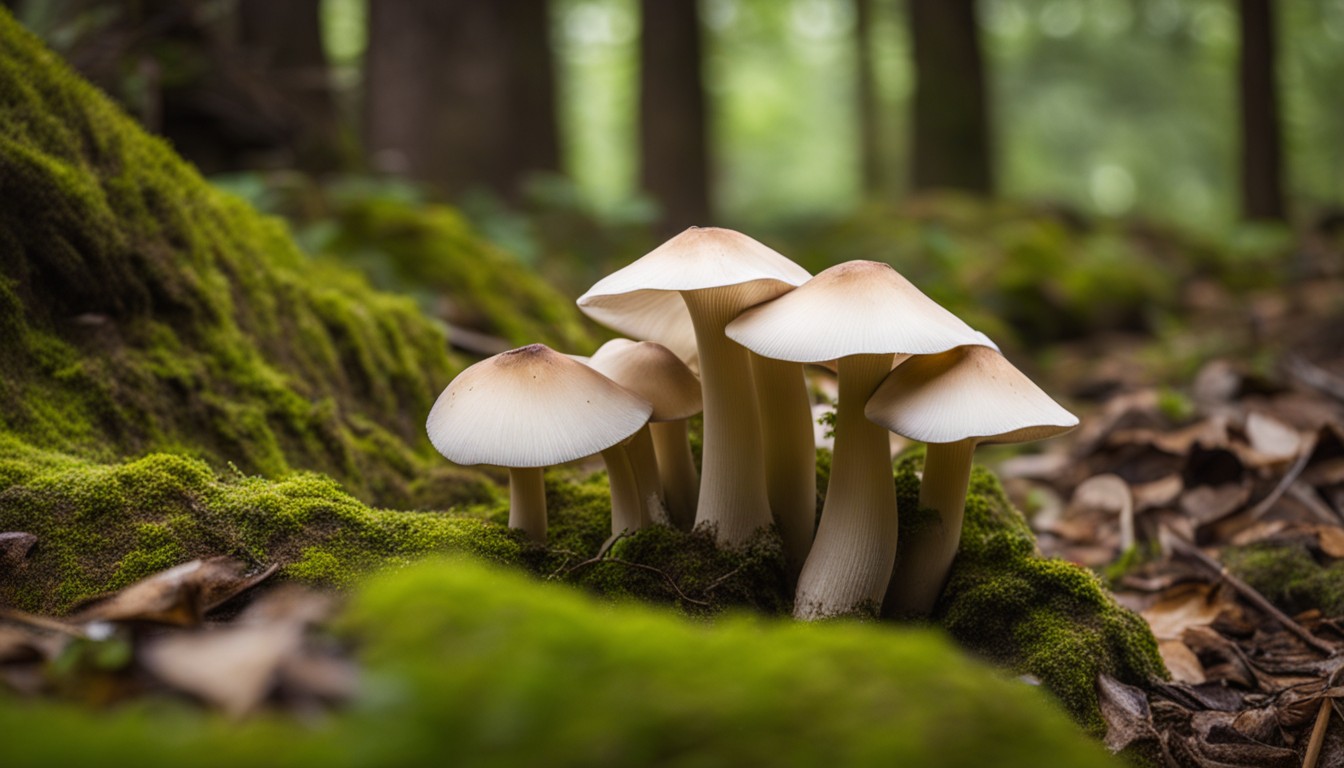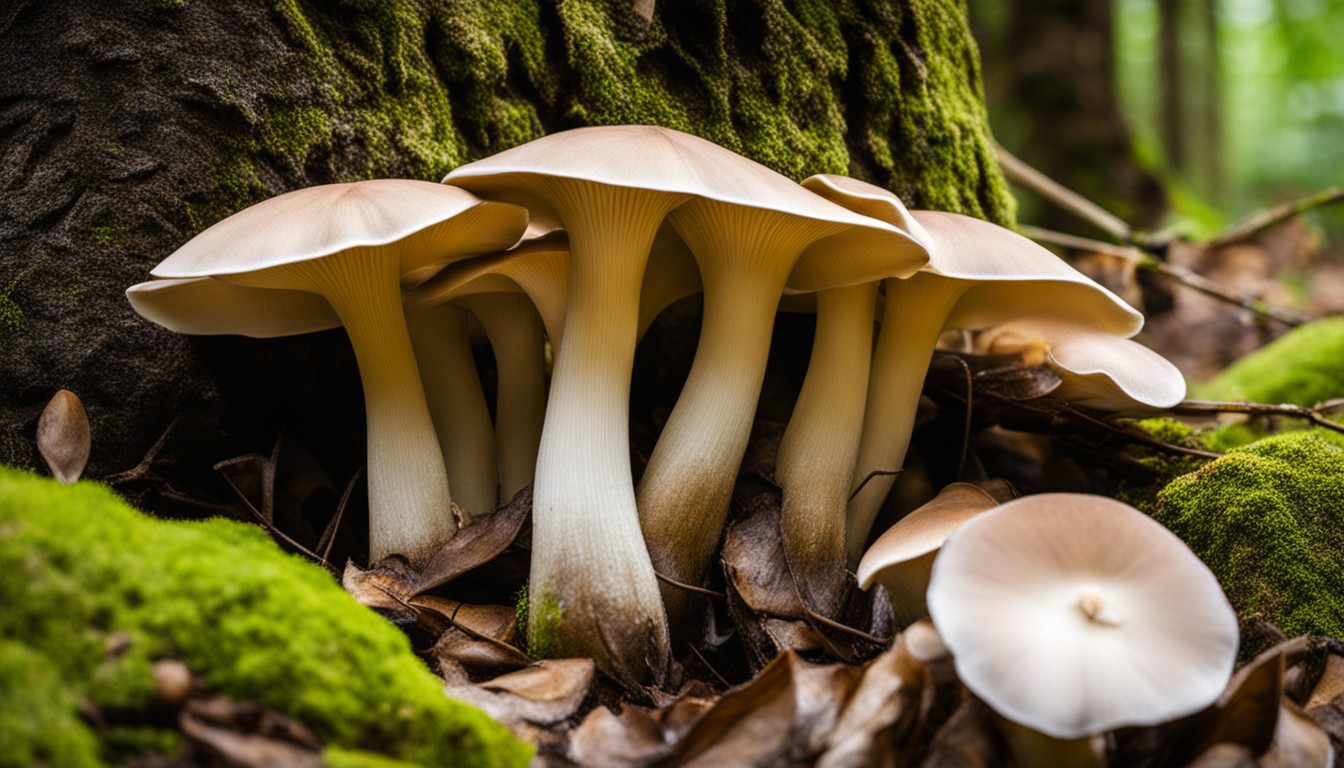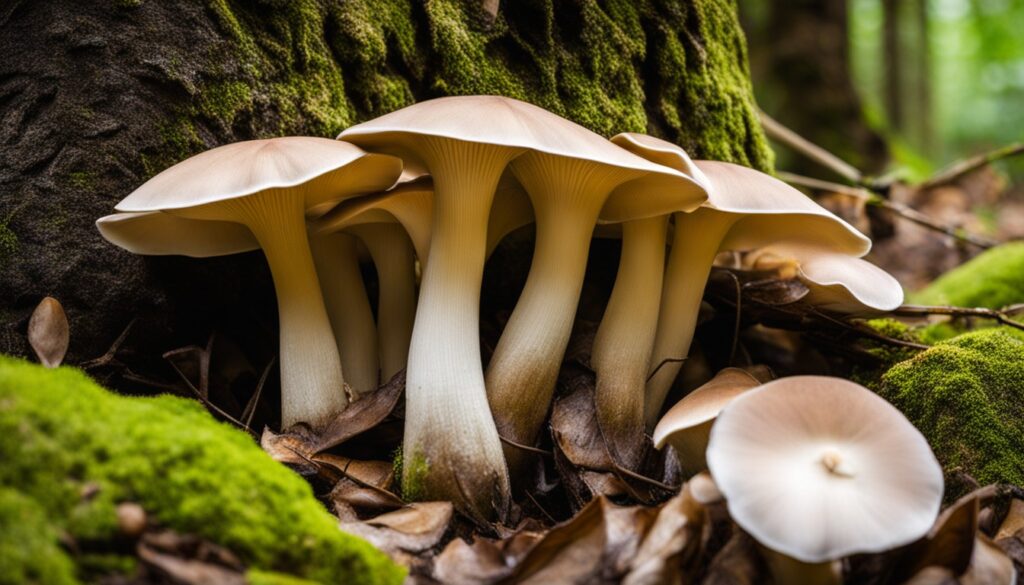Oklahoma Wild Mushrooms: A Guide to Identification and Safety is an extensive resource that provides detailed information on the various types of wild mushrooms found in Oklahoma. This comprehensive guide not only focuses on the identification of these mushrooms but also emphasizes the importance of safety measures when foraging for them. With expert tips and advice, this blog post ensures that readers gain a thorough understanding of the different species of wild mushrooms in Oklahoma while staying safe during their exploration. Whether you’re a beginner or an experienced forager, this guide is a must-read for anyone interested in the fascinating world of Oklahoma wild mushrooms.
Why Identify Wild Mushrooms?
Identifying wild mushrooms in Oklahoma not only serves to ensure safety during foraging but also amplifies appreciation of the state’s ecological diversity. The variety of mushrooms found across Oklahoma’s diverse habitats – from humid woodlands to open prairies – play vital roles in these ecosystems, decomposing organic material, aiding plant growth and establishing sustainable environments.
Through the proper identification of wild mushrooms, enthusiasts can appreciate the sheer variety of fungal life in Oklahoma. The state serves as host to a stunning fungal tapestry, each component of which contributes uniquely to the local ecology. Identification serves as a testament and tribute to that diversity, celebrating the natural wonder found in our everyday lives.
The Importance of Proper Identification
Accurate mushroom identification is a cornerstone of sustainable foraging. It promotes the preservation of diverse fungi species, minimizing the risk of widespread eradication of certain mushrooms through thoughtless collecting habits.
Accurate mushroom identification fosters sustainable foraging, preserves biodiversity, elucidates ecological roles, and expands culinary possibilities, unveiling Oklahoma’s rich gastronomic potential.
Mushrooms are an intricate part of the ecosystem. Correct identification helps in understanding their role in nature, whether it’s in decomposition, recycling nutrients or symbiosis with plant life.
Furthermore, the precise determination of mushroom species expands culinary boundaries. Oklahoma’s wild mushrooms, when appropriately identified, can provide unique flavors and textures to both traditional and experimental cuisine.
An overlooked mushroom in the woods could be a flavorful addition to a meal or a valuable commodity in the local market. Hence, reliable identification not only ensures safety but also uncovers Oklahoma’s fascinating culinary potential.
The Dangers of Misidentification
Deceptively benign-looking, several species of wild mushrooms bear dire consequences for those who misidentify and consume them. Accidentally eating toxic varieties can result in a wide spectrum of health issues, from mild gastrointestinal distress through to severe liver damage, and in extreme cases, death.
A landmark instance took place in Oklahoma, where a family of five suffered acute poisoning. This arose from confusing the harmless white button mushrooms with their lethal counterparts, Amanita Phalloides, emphasizing the stark potential dangers.
Furthermore, another case in Oklahoma witnessed the unexpected adverse effects of eating misidentified mushrooms. A couple mistook the hallucinogenic Psilocybin mushrooms for the edible Psathyrella species, resulting in severe psychoactive complications.
Ingesting wrongfully identified varieties may not always produce immediate symptoms, giving the deceived a false sense of security. However, these often manifest over time, making treatment difficult due to their extreme toxic effects.
Not all effects are physical; the psychological distress endured by loved ones witnessing the sudden decline in health of anyone affected adds another layer to the danger. These examples serve as cautionary tales, emphasizing the critical need for accurate identification of wild mushrooms before consumption.
Benefits of Identifying Wild Mushrooms
Amateur mycologists who accurately identify wild mushrooms substantially contribute to the richness of scientific knowledge. Their diligence in the field aids in mapping out species distribution, advancing our understanding of local ecosystems.
In Oklahoma, the identification of wild mushrooms enriches outdoor recreation. By learning about native fungi, individuals gain a deeper appreciation for nature’s intricacies, adding an exciting layer to their foraging or hiking experience.
Basic Anatomy of Wild Mushrooms

From the base of the stem known as the stipe, to the underside of the cap packed with gills, the basic anatomy of wild mushrooms is no mystery. This intricate structure is more than merely fascinating; it is instrumental in accurately identifying the various types of wild mushrooms populating the Oklahoma wilderness.
Understanding the Cap
The cap, nature’s umbrella draped over the mushroom, reveals key features that aid in identifying different species. It may seem like an ordinary overhead dome, but its color, shape, and texture offer clues to, which keep us informed about the mushroom’s identity.
- Observe the cap’s color: The color can range from vivid to subtle, or drastically change as the mushroom matures
- Examine the cap’s shape: It can vary significantly, from flat to conical or bell-shaped
- Inspect the cap’s texture: Texture varies too – could be smooth, scaly, slimy, or dry
- Consider the cap’s size: From minuscule to expansively large, size adds another layer to identification
- Look for any changes in the cap: Some caps change color or shape as they age, hinting at the mushroom’s maturity level
Examining the Gills
Conducting a careful examination of the gills – the fine, rib-like structures on the underside of the cap – is critical for correctly identifying a wild mushroom species. Note that the structure and color of the gills can reveal critical information about the mushroom’s identity.
- Check the attachment of the gills to the stem: some are free, while others are attached or decurrent.
- The gill color: it might vary from white to brown, or even bright colors, depending on the species.
- The gill spacing: closely spaced gills may lead to different mushroom families than those with widely spaced ones.
- Observe the edges of the gills: whether they are smooth, notched, or serrated.
- Any changes in color or other features when bruised or aged.
Inspecting the Stem
A meticulous examination of the mushroom stem or stalk is crucial for accurate identification. The stem’s unique characteristics serve as vital clues in distinguishing between different mushroom species.
- Check for shape: The stem could be bulbous, equal, or tapering.
- Identify color: Different species may have variations in stem color.
- Note the texture: The stem could be smooth, rough, or have other distinct textures.
- Look for a ring or skirt: Some mushroom stems have a ring-like structure.
- Check for stem solidity: Stems can be either hollow or solid.
- Investigate base: The base might be bulbous, rooting, or even absent in some species.
Common Wild Mushrooms Found in Oklahoma

Field Guide: Keeping Oklahoma’s abundant diversity of fungi species in mind, some of the most commonly identified include Chanterelles, Morels, Chicken of the Woods, and Lobster Mushrooms. Each brings its own characteristics and distinct flavors to the table.
Diverse and Delicious: Featuring a range of colors, textures, and taste profiles, Oklahoma’s wild mushrooms cater to various palate preferences, further underscoring the necessity of meticulous identification for both safety and gastronomical fulfillment.
Chanterelles (Cantharellus spp.)
Chanterelles, also known as Cantharellus spp., are a culinary delight found thriving on the forest floors of Oklahoma. Noted for their soft color variations and unique appearance, their successful identification can make a foraging trip truly rewarding.
- Look for a characteristic yellow to orange color
- Chanterelles usually have a smooth, wavy cap
- They sport a distinct funnel shape
- Decaying wood could be an indicator of Chanterelles
- Appear in late spring to early fall
- Note the absence of true gills – instead, they have vein-like wrinkles
Morels (Morchella spp.)
Morels, scientifically referred to as Morchella spp., are a highly sought-after wild mushroom in Oklahoma due to their unique honeycombed appearance and rich, earthy flavor. Proper identification is crucial to safely enjoy Morels’ culinary delight.
- Morels typically have a honeycomb-like appearance with a cap full of deep pits and ridges.
- They exhibit a cone or round-shaped cap that is usually dark brown, grey, yellow, or black.
- The cap is generally attached to the stem without a dangling skirt.
- Morels have a hollow interior when sliced longitudinally from cap to stem.
- They usually appear in spring, making hardwood forests and old apple orchards their chosen habitats.
- False Morels, although similar looking, are poisonous and differ in having a wrinkled rather than pitted cap and may have a cotton-like substance inside.
Chicken of the Woods (Laetiporus sulphureus)
A vibrant jewel in Oklahoman woodlands, Chicken of the Woods features a bright-orange hue and a layered fan-like formation making its identification relatively simple. Harvest by cutting at the base, as pulling may damage mycelial structures or disturb other mushrooms.
Not just a visual standout, Chicken of the Woods (Laetiporus sulphureus) boasts a texture and taste comparable to chicken, earning it a beloved spot in the culinary world. Collected young and properly cooked, this fungi brings a magical woodland essence to your dish.
In Oklahoma, understanding this particular fungi’s identification is crucial, with its distinguishable color and form providing a relatively safe starting point for novice foragers. Remember, always cross-reference your finds to avoid the risk of poisoning.
Lobster Mushrooms (Hypomyces lactifluorum)
Oklahoma’s Lobster Mushrooms, an unmistakable find, are particularly unique due to their red, lobster-like coating. This identifiable trait is key to safely distinguishing Hypomyces lactifluorum from potentially harmful look-alikes during your wild harvest.
Mastering the identification and collection of these mushrooms adds an exciting venture to foraging. The crustacean-like shell, although indicative of a parasitic process, provides an oddly appealing charm; a treasure among Oklahoma’s woodland flora.
Noteworthy, beyond that hardy exterior, one would reveal a white, firm flesh, adding to its seafood semblance. It’s this combined spectacle—exterior and interior—that truly sets Lobster Mushrooms apart while ensuring safe foraging.
Appreciation for Lobster Mushrooms goes beyond aesthetics, they enrich local cuisines with their hearty texture and subtly peppery notes. Indeed, mastering the collection and identification of Lobster Mushrooms unveils a captivating realm of foraging in Oklahoma.
Warning Signs and Poisonous Mushrooms
The silent danger: Oklahoma’s wild holds a diversity of mushroom species, including the poisonous. Recognizing warning signs and distinguishing poisonous varieties is critical to ensure safe foraging.
Avoiding poisonous pitfalls: By knowing extensively about dangerous mushroom species in Oklahoma, mushroom enthusiasts can take a sure-footed approach while exploring nature’s bounty and steer clear of potential hazards.
The Deadly Galerina
The Deadly Galerina, unassuming yet deadly, can be a lethal mistake for novices in mushroom foraging. Hence, the correct identification of this mushroom in Oklahoma is of utmost importance to prevent the dire consequences of its consumption.
Recognizing the Deadly Galerina involves scrutiny of its brownish cap, white to cream gills, and the rusty brown spore print— identification keys that are crucial to ward off potential dangers. A slight mistake can lead to severe poisoning and, in extreme cases, death, making this one of Oklahoma’s most perilous mushrooms.
Destroying Angel (Amanita spp.)
Identified as a burgeoning threat within Oklahoma’s wild, the Destroying Angel, acknowledged scientifically as Amanita spp., has deservedly earned its ominous reputation. Known for its lethal toxicity, this seemingly innocent mushroom poses substantial threat to the unaware forager.
Typically characterized by its stark white color and prominent volva, a bulbous structure at the base of the stem, Amanita spp. blends into the woodland with a deceptive innocence. Consequentially, this incognito menace draws foragers into a deadly trap, often mistaken for edible counterparts.
It’s pivotal to dispel some prevailing myths surrounding the Destroying Angel, which have, unfortunately, contributed to numerous poisonings. One common fallacy suggests cooking or peeling the mushroom eliminates the toxicity. This couldn’t be further from the truth; no culinary process can render it safe to consume.
Even in small quantities, ingestion of Destroying Angel can lead to severe consequences including renal failure, hepatic dysfunction, and in the most extreme circumstances, death. A single specimen carries enough amatoxins, the mushroom’s primary toxin, to cause fatality.
Upon possible encounter with Amanita spp. within Oklahoma, safety ought to be the top priority. Best practice advises leaving the mushroom untouched; ingesting even small amounts or inhaling spores can have devastating effects. Using gloves, containers, or dedicated tools to handle the mushroom significantly reduces risk of contact.
Phalloides (Amanita phalloides)
In the fascinating yet potentially lethal world of Oklahoma’s wild mushrooms, Phalloides, or Amanita phalloides, is a fatal fungal species to watch out for. Identification markers include a pale to olive green cap and white gills beneath.
One deadly characteristic of the Phalloides is its widespread umbrella-shape cap which can vary from 2 to 6 inches. Although the cap size may seem benign, it is often a lurking red flag for toxicity.
Beware of the innocent look of this fungus. Many mushroom foragers have been deceived by its deceptive resemblance to several edible species, leading to grave consequences.
The Phalloides Amanita resembles some of Oklahoma’s edible mushroom species like the Paddy Straw and the Horse Mushroom. This uncanny similarity often leads to its misidentification by many, ultimately resulting in fatal ingestion.
Distinguishing features like a large membranous ring on the stem and volva at the base help differentiate the deadly Phalloides from other mushrooms. These distinguishing characteristics should be noted for ensuring safe mushroom foraging.
Safe Practices for Mushroom Foraging

Passion, when honed through proper education and expert direction, turns into a fruitful skill. By adopting responsible foraging practices amidst Oklahoma’s rich mushroom terrain, you not only ensure safety but potentially discover a nourishing hobby.
Transforming the multisensory pleasure of foraging from the field to the kitchen asks for heightened responsibility. Oklahoma’s varied mushrooms promise culinary treasures, but only when foraged and identified responsibly, ensuring safety and edibility.
Educate Yourself and Seek Expert Guidance
Never underestimate the importance of education and expert guidance in mushroom foraging. When you gain deeper knowledge, your ability to identify various species sharpens, significantly improving your foraging experience.
Walking with confidence in wild foraging scenarios hinges heavily on the extent of your mushroom knowledge. Education and expert guidance help mitigate risks, ensuring a safer excursion into Oklahoma’s diverse forests.
In the ever-changing world of wild mushrooms, staying updated with the latest identification techniques and information is crucial. This pursuit of continuous learning helps you level up your foraging game and allow for safer and more productive outings.
Start Slow and Gradually Expand Your Knowledge
Slowly embarking on your mushroom foraging journey allows you to fully understand the subtleties of each species. This patient approach mitigates potential risks and contributes to a more rewarding experience, consolidating your foundation knowledge in mushroom identification and safety.
Beginning your foraging endeavors with easily recognizable species can serve as a confidence boost. As your understanding deepens, you can gradually incorporate more complex species, enhancing your expertise and adapting to the inherent challenges of mushroom hunting.
Gradual learning in mushroom identification underpins safe foraging. Every new species discovered and correctly identified amplifies your foraging skills, helping you refrain from potentially dangerous misidentifications.
Delving into the art of mushroom foraging, emphasising gradual learning, elevates the protective measures in place for mushroom harvesters. A slow yet consistent pace of learning is a key factor in mastering safe and successful mushroom foraging.
FAQ: Oklahoma Wild Mushrooms
Explore the frequently asked questions about Oklahoma’s wild mushrooms to enhance your knowledge and ensure a safe and rewarding foraging experience.
1. What are the key steps for accurately identifying wild mushrooms in Oklahoma?
Accurately identifying wild mushrooms in Oklahoma requires careful observation of key characteristics such as color, shape, texture, and the presence of specific features like gills or pores.
2. Are there any poisonous mushrooms in Oklahoma that I should be aware of?
Yes, there are several poisonous mushrooms in Oklahoma. It is crucial to avoid consuming any wild mushrooms unless you are confident in their identification or have expert guidance.
3. Can I eat the wild mushrooms I find in Oklahoma?
While there are edible wild mushrooms in Oklahoma, it is essential to exercise caution and only consume those that have been positively identified as safe by a knowledgeable expert.
4. What precautions should I take when foraging for wild mushrooms in Oklahoma?
When foraging for wild mushrooms in Oklahoma, it is crucial to use reliable field guides, wear appropriate protective gear, and always cross-reference your identification with experts to ensure safety.
5. How can I contribute to the conservation of Oklahoma’s wild mushrooms?
To contribute to the conservation of Oklahoma’s wild mushrooms, avoid over-harvesting, respect natural habitats, and report any rare or unusual finds to local mycology organizations or experts for further study.
6. Can I cultivate wild mushrooms at home in Oklahoma?
Yes, it is possible to cultivate certain wild mushrooms at home in Oklahoma by creating the right growing conditions, using proper techniques, and starting with high-quality mushroom spawn or spore prints.
7. Are there any guided mushroom forays or workshops available in Oklahoma?
Yes, there are guided mushroom forays and workshops available in Oklahoma, typically organized by local mycology clubs or nature centers. These events provide valuable hands-on learning experiences and opportunities to connect with fellow mushroom enthusiasts.
Remember, when in doubt, always consult with experts and prioritize your safety when engaging with Oklahoma’s wild mushrooms.
Conclusion
To ensure safety and fully experience the vibrant world of Oklahoma’s wild mushrooms, proper identification is crucial. Not only will this allow you to enjoy foraging, it crucially ensures the avoidance of dangerous look-alikes.
- Ensure proper mushroom identification for safety
- Start with common, easy to identify species
- Seek expert guidance for unfamiliar mushrooms
- Never consume a wild mushroom unless you’re absolutely certain it’s safe
- Always keep in mind: ‘When in doubt, throw it out’
- Remember foraging etiquette: leave enough behind for wildlife and future growth

